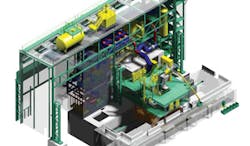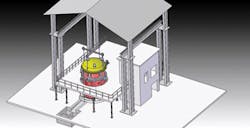With rising expectations from automakers and commercial vehicle manufacturers, and increasingly for oil-exploration and mechanical engineering applications, steel foundries are getting serious about their clean-steelmaking technologies. One obvious effect is a new class of vacuum treatment plants scaled to metalcasting operations.
Higher-grade steels require secondary treatment, often carried out under vacuum, and while such plants are common in primary steelmaking and stainless steel production, they have been less common for producers of steel castings. And, it’s not only the scale of the vacuum operations that have changed, but also the process and control technologies used to execute that stage of production.
Degassing steel under vacuum generates gases and vapors that may be dangerous to the operators, as well as the capital equipment. Essentially, CO and H2, along with the fumes of volatile metals, are released from the steel surface. Metal and metal-oxide gases partially condense on cold elements and generate a fine dust. That dust must be efficiently separated in special bag filters, cyclones, and containers so that it does not reach the vacuum pumps.
Explosion protection in vacuum plants, especially those that generate a large quantity of CO by using oxygen for decarburization, has been accomplished by over-pressure flaps at the metallurgical reaction vessels, alarm devices for water leaks, sensors for pressure and temperature as well as emergency venting with nitrogen.
With the introduction of mechanical vacuum pumps, more efficient gas cooling and dust separation became necessary.
During a typical steel degassing process, potentially flammable fuels as CO or H2 are produced, but such gases are not dangerous unless mixed in the right concentration with oxygen. So, oxygen increases the risk of explosion.
Yet, oxygen cannot be eliminated, as leakages cannot be ruled out completely, and the use of oxygen is mandatory for certain manufacturing processes. Primary vacuum pumps that require high-volume air-cooling may increase the chances of an explosive gas-mixture.
The entire arrangement is a complex one that many steel foundries have not taken on — until recently.
Designed, Installed, Operating
A 50-metric-ton capacity vacuum oxygen decarburization (VOD) plant designed by Siemens Metals Technologies has started up for at Voestalpine Giesserei Linz GmbH, an Austrian foundry affiliated with Voestalpine Stahl, a steelmaker. The new unit is powered by electrically driven mechanical vacuum pumps rather than steam injectors, avoiding in that way the need for an adjunct steam-generating system.
The Linz foundry (Voestalpine Giesserei also operates a nonferrous foundry in Traisen, Austria) casts engineered components (10 to 200 metric tons) for specialty manufacturing equipment, including hammer heads and housings for forging machinery; rolling mill housings; slag ladles; castings for steam turbines, gas turbines, and gas pipeline compressors; and products for petrochemical and oilfield installations.
The group also has metalcasting plants in Yinchuan and Shanghai, China, and produces approximately 35,000 metric tons/year of steel, ductile iron, and nonferrous castings.
The new degasser expands Linz’s secondary metallurgical processing options, allowing it to expand its product portfolio and helping to make clean steel production more cost-efficient.
Siemens Metal Technologies designed the treatment process and all the core components the treat including a ladle hood specially fabricated from copper-plated sheet, intended to minimize the collection of hardened slag adhering to the rim of the ladle and the vacuum lid. It also designed and supplied the vacuum lid, an oxygen-blowing lance system, a gas cooler and a filter system, mechanical vacuum pumps and the hydraulic system.
The original order also included a water management system designed to coordinate with the overall operation, all vacuum process control instruments, and a complete automation technology package.
The combination of electrical- and mechanical-powered vacuum pump technologies includes roots blowers and screw compressors, and is among the first of its type for VOD operations. Unlike the conventional steam injectors used in secondary metallurgy, it requires no process steam, so there is no need for external steam or the installation of a separate boiler to generate steam. Those factors reduce the operating cost and the risk of an explosion.
Siemens also developed a small-scale vacuum degassing operation for an Indian steel producer, Jailaxmi Casting & Alloys Pvt. Ltd., which ordered 35-metric ton process for its plant in Aurangabad.
Siemens is not alone in developing new vacuum degassing technologies for smaller-scale operations. Danieli & C. SpA developed a 25,000-metric tons/year specialty steel foundry (low- and high-alloy carbon steels and stainless grades) for a new joint-venture operation in Chelyabinsk, Russia. BVK Ltd. is producing specialty valves, fittings, and other components for oil-and-gas pipeline projects. With a plant design adapted from electric furnace-based minimill projects, the foundry features a VD/VOD station powered by dry mechanical pumps as part of the steel treatment technology.











